DAOstack. An operating system for collective intelligence
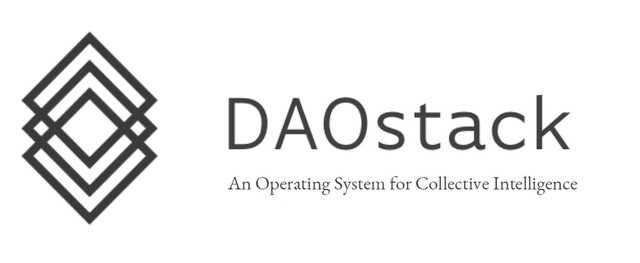
Introduction
The arrival of the Blockchain created the capacity to exchange values or currencies in a secure (privacy) and reliable (transaction transparency), without intermediaries (simplification) way. Its decentralized nature prompted the creation of decentralized autonomous organizations or DAOs. The DAOs come to form networks incentivized by cryptocurrencies cooperating under common objectives, sharing resources among them. However, the scalability and resilience of these organizations are compromised by not having an adequate system of decentralized governance.
DAOstack is an operating system for DAOs, designed to boost the future of collaboration. DAOstack allows defining in a simple way through its framework a governance structure based on schemes and constraints tested and approved by the DAOstack team. DAOstack makes things easier for decentralized application (DApps) developers to configure the governance protocols of DAOs and control the collective administration of resources, increasing the decision-making capacity of organizations.
The following essay will explain how the DAOs will be the next evolution of the organizations we know today and how the DAOstack team will make this premise a reality through its platform.

Evolution of organizations
Since the beginning of time, man has been characterized by being a social being, coexisting with his fellow human beings in tribes and communities, constantly growing. Societies always are based on hierarchical schemes. Where a minority decides, directs and governs the masses. However, the exponential increase in population growth has oriented humanity towards an interconnected global civilization. We are at a point where hierarchies no longer have the capacity to handle the problems facing societies today, such as global pollution, the market, climate, the control of new diseases, etc. That leads these schemes to obsolescence.
The same happens with the growth of organizations, there comes a time that is not able to solve problems exponentially, collapsing and stopping their progress. That is why it is necessary to develop a tool or model that allows societies to coordinate the processes of decision making and actions, as a single entity, as a collective intelligence.
This model of collective intelligence is present in the environment that surrounds us. The term stigmergy, was a concept introduced at the beginning of the 60s, to explain how social insects (such as ants) managed to perform tasks without the need for planning or a central entity.
The Internet was basically created as a decentralized structure that established the exchange of information at the global level. Interconnecting millions of users. This new paradigm pushes organizations to new levels of efficiency and cost reduction. However, it is only with the creation of the Blockchain, which allows the birth of a new decentralized economic model, which supports the distribution of values, ensuring security, confidence and reducing the problems of failures. The blockchain forms the technological basis for decentralized autonomous organizations or DAOs. This will be the new evolutionary trend for organizations nowadays. Nonetheless, DAOs have remained largely as an abstract idea, due to the lack of solutions for Decentralized Governance.
This is where DAOstack comes in as a response to boost collaboration, allowing collectives to organize themselves under common objectives and values without having to fall into centralized power centers, thus avoiding compromising decentralization.
DAOstack establishes a platform that guarantees Decentralized Governance, through a totally open architecture, thus allowing its updating and scalability.

DAOs
A DAO is an interconnected network of smart companies or agencies. Agencies are a governance unit that executes smart contracts in the blockchain. Which has its own token, a system of its own reputation and its own governance protocol (codified within smart contracts.).
This network does not have a central administration that coordinates the agencies, the relationships between the agencies are established by incentives and code. The mesh can not only be made up of agencies, but also by other DAOs. The power of decision-making, within the mesh, is distributed meritocratically, to take advantage of collective wisdom, benefiting the organization as a whole.
Complex network of a DAO
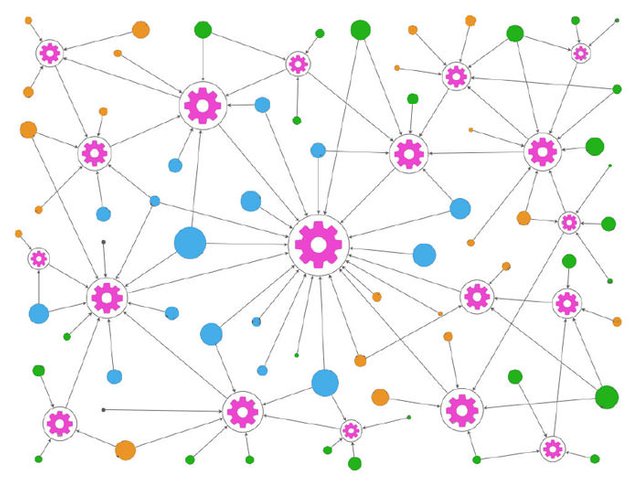
The filled circles represent the agencies, their distances to the center represent the reputation (influence of power), the size represents the number of tokens they have.
Functionalities of the Agencies
Token distribution: each agency or DAO can issue and distribute its own native token.
Funds allocation.: an agency can use its funds to compensate its taxpayers. These funds can be reserved, earned or exchanged by other tokens of other DAOS or ETH. including the GENs, which are the tokens of the DAOstack (these will be explained later).
Reputation assignment: Each agency can assign reputation levels to its members. Reputation represents the power of influence within the organization. The reputation is not transferable, it is granted or won by the members according to their merits and contributions.
Collective data curation.. Each organization must be responsible for a well curated, editing or preservation of its articles or contents. A good curation represents a value that can be monetized. In this way the wisdom of the masses is used to classify the quality of anything.
External Activity. An agency can influence other agencies or DAOs (influencing their votes)
Governance upgrade. Each agency can define its functions, eliminating or adding more elements, in this way it is possible to change the governance schemes (these will be explained in the next section).

Blockchain Governance
Initially the governance of the blockchain depends on the agencies. Agencies are nothing more than basic units that establish governance within the blockchain. The agencies generate the tickets based on certain rules that are applied to the blockchain and this in turn generates a result. These rules are based on a reputation system that is better than the use of votes generated by the weight of the agency's own native tokens; this reputation system that is responsible for the power of influence that an agency has over the blockchain
Blockchain Governance Structure
The governance of the agencies are divided into two types:
Governance Schemes: are a series of instructions programmed to take the entries introduced by the agencies and process them to obtain a result. The schemes are based on proposals that are approved by a system of yes and no votes. An example of these is: a simple reward system. An agency issues a proposal to reward with 200 tokens. Either vote yes or no on the proposal. When the majority of DAO's reputation holders obtain the yes, the system will execute the proposal.
Global Constraints: are specific conditions that limit the functionalities of a particular agency. Example of these: An upper limit imposed on the total number of tokens that can be issued by the organization.
Scalability
Decentralized governance systems need to be open to any participant that complies with the schemes and constraints of an organization. That's why you should be able to weigh every decision that all the participants of a DAO issue. To resolve (to some extent) the tension of the scalability and resistance of a decentralized government system, three aspects should be taken into account:
- Compositionality. Decisions can be made much faster depending on the structure of the organization. For a assembly structure, 5 agencies are required to make a decision, however, for a fractal or federated structure, only 4 agencies are needed. However, we can say that the resilience for the second case may be weaker or stronger, depending on the situation.
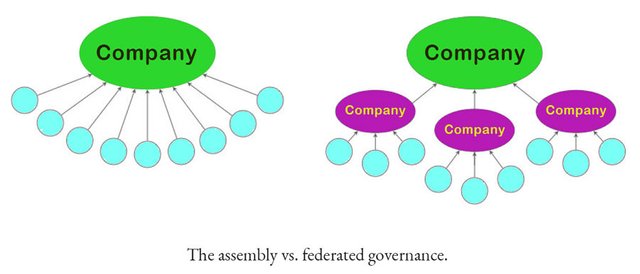
Monetization of Attention. To make decisions, voters are needed and to call to buy voter attention it is necessary to use tokens. These token can be the native token of a DAO or GENs if it is between DAOs. You should keep in mind that they will only be used to attract more voters, not to influence the decisions made.
Relative Majority. This means that most approvals are only with respect to those who cast their vote and not to all potential voters in the system. However, it takes a certain time for a proposal to be considered. To solve this problem, previous government systems introduced the quorum concept: a minimum amount of voting power for a decision to be approved. The problem with the quorum is that it is impossible to set the correct amount, as it could affect the scalability of the system or its capacity for resilience. The quorum needs to be dynamic. This is where we propose the concept of holographic consensus.
Holographic Consesus
In any decentralized governance system there is a main tension between resilience and scalability.
The resilience means the tolerance and resistance of the system to a defective behavior: it is caused by fraud or simply due to a bad consideration of the proposals. On the other hand, scalability is the ability of a governance system to process a large number of decisions in a given period of time, regardless of the number of agents that participate.
These problems can be solved through the basic principle of holographic consensus. We apply the notion of hologram in this scheme, where each of the pieces of the hologram contains the information of the hologram in its entirety.
In the holographic consensus, we want to be able to predict the decisions made by the small groups on behalf of the great majority and extrapolate to the decision that the majority would have taken if there was sufficient attention. To eliminate possible imbalances, we present a novel prediction game, in which anyone can make predictions, backed by a bet, on the fate of the proposals.
Discovering these social imbalances or inefficiencies is the most important part of making collective attention more efficient and achieving a more scalable system of governance. By providing predictions backed by bets (paid in tokens), predictors provide valuable signals to governance over proposals that are overvalued or underestimated.
An example to consider in order to appreciate the prediction game paradigm is the following: an agency can identify an undervalued proposal and place a bet of 100 GEN on the prediction that this proposal will pass once collective attention is obtained. By playing the prediction game, predictors contribute to the process by signaling, filtering and maintaining the governance process

The DAO Stack
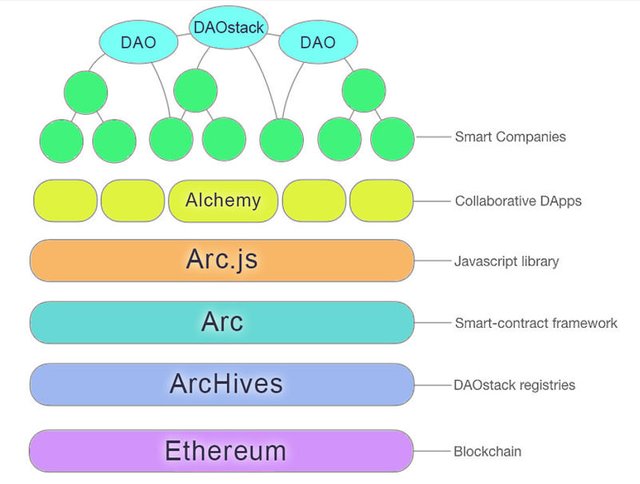
DAOstack allows the development of decentralized applications in a simple way, with customizable tools for the administration of common resources, decision making, budgeting and incentivation
Let's take a closer look at the DAOstack
Arc
All the DAOs are made of intelligent contracts, established in the Ethereum Blockchain through Arc. Arc allows you to create, configure and deploy intelligent contracts on the blockchain. It is an open source, modular and general purpose framework; it is not limited to a specific governance system. It allows agencies to create their own governance system, defining their schemes and restrictions, issuing, maintaining and assigning tokens; including the definition of the reputation system.
Arc was designed with the following principles in mind:
Generality: Arc allows any type of governance element. Arc contains a library of schema templates and global constraints for governance systems.
Modularity: the Arc framework allows to create a governance structure for the DAOs in a modular way, adding, eliminating or combining elements or blocks.
Simplicity: the modularity of the framework ensures the simplicity of the system.
Upgradability: the governance structure of each DAO can be upgraded to use new schemes and restrictions. It also allows to change existing ones. Because within the rules of created governance, there will always be a rule to change the rules.
Interoperability: Arc is designed to facilitate interaction between different agencies and DAOs. Allowing the exchange of tokens, acquiring forms of agreements and reputation systems with other agencies.
Open System: Arc is an open source framework, allowing independent developers to create their own apps, integrations and templates on it. DApps can also interact with other DApps that are developed on Arc. We hope that DAOstack will attract developers from the Ethereum community to develop their own governance modules and their DApps.
Arc.js
Arc.js is a JavaScript library built on Web3.js (Ethereum JavaScript API), in this way it allows developers to create DApps on Arc, without needing knowledge of the Solidity language.
The ArcHives
ArcHives are the shared and curated records of the DAOstack. It provides a central place for the integrity of the data and the quality of the data. The basic ArcHives of DAOstack are: Compendium, Mosaic and Hive Registries.
Compendium
It is the DAOstack repository where the templates of governance schemes and constraints that have been audited, tested and approved by the DAOstack expert community are saved. Implementing our own "app store".
Saving a new governance module in the compendium incurs a cost of GENs. It also allows independent developers who have registered their own governance models approved by the DAOstack community to receive GENs for the use of their models by other DAOs. The models developed by the DAOstack team are free of charges for the community.
Mosaic
It contains a record of all the agencies and DAOs established through the Arc framework. It is a critical database for the interaction of DAOstack ecosystem organizations and DApps. Likewise, it entails a cost in GEN, registering or promoting organizations within the Mosaic. The Mosaic implements a search engine to facilitate the discovery of the agencies.
The Hive
It is an open billboard that everyone (innovators, professionals and stakeholders) can use to post applications or offers, which are registered or promoted by spending GENs. The hive implements a search engine to facilitate the discovery of posts.
Alchemy
DAOstack developed its own native DApp called Alchemy, which creates a simple interface with Arc, facilitating the configuration of the governance protocols of the agencies and DAOs; allows to make proposals and vote on existing proposals and allows the collective administration of resources which increases the decision-making capacity of the organizations.
The GEN Economy
GEN is the token used to draw the collective attention of humans within the ecosystem DAOstack, on Ethereum blockchain. The general idea is to distribute the tokens among the developers of DApps, agencies and DAOs and on the other hand, the use of the DApps will require the expenditure of the same tokens. Generating what we call a circular economy of the token. The tokens are also used to drive the prediction games described above for holographic consensuses.
The GEN Model
DAOstack is a DAO that involves three categories: Decentralized collaboration, where tokens are encouraged to developers to work in the DAOstack ecosystem. Cooperativa decentralizada, since it uses the funds collected by the sale of tokens to invest them in decentralized projects associated with the DAOstack or that help improve the ecosystem. Finally, it establishes a decentralized healing network, a place for the registration of objects or articles to be cured by the network. Where the content promoters must pay to post their articles, and their reputation will increase or decrease depending on the quality of the post.

Conclusion
DAOstack is a complete new tool that will change the way in which human beings coordinate the distribution of resources, their decision making and their production of meaning ... from the collective point of view. DAOstack strives to create a collective intelligence. Changing governance in a way that does not compromise decentralization, maintaining openness, preventing it from falling back into centralized decision making.
DAOstack is a completely open architecture, which allows its constant updating and improvement and better support.
The DAOstack ecosystem will allow participants to create and vote proposals, transfer tokens automatically when proposals are approved, reward contributors with both tokens and reputation (voting power).
The first principle of designing the DAO stack was not to build a specific protocol or a specific application, but rather to build the soil, the ground from which a whole ecosystem can grow and thrive

Annexes
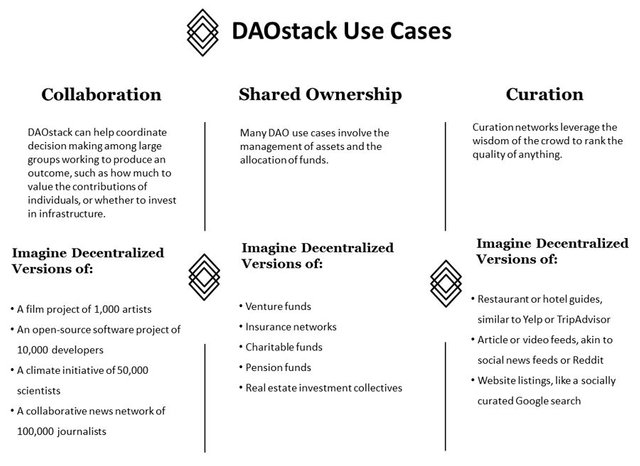
Smart Contract Architecture of the Arc framework:
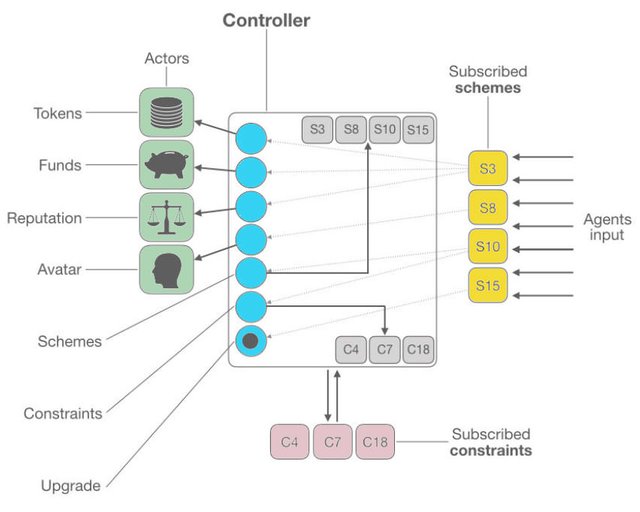
The GEN Distribution
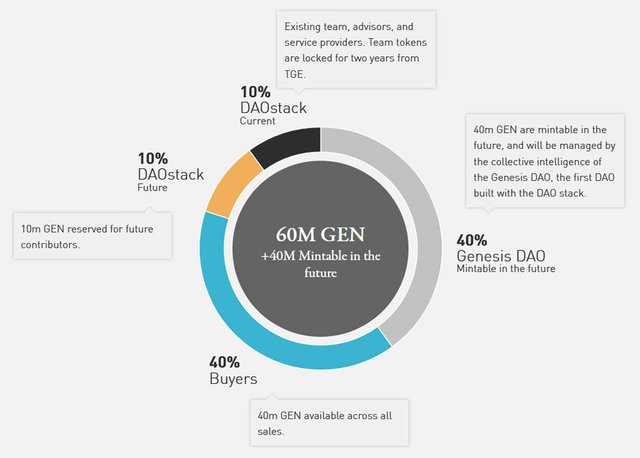
Roadmap
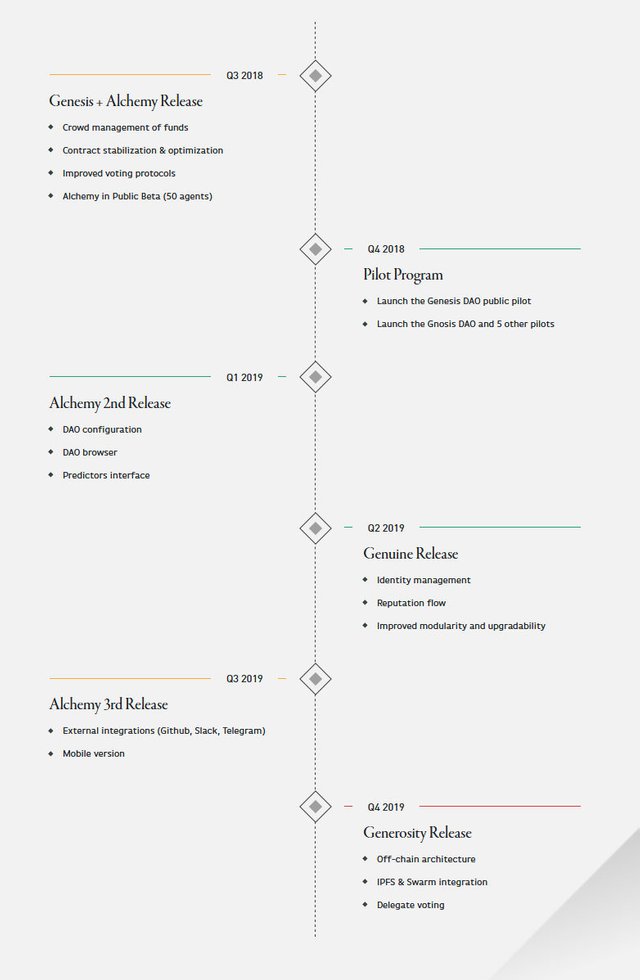
Team
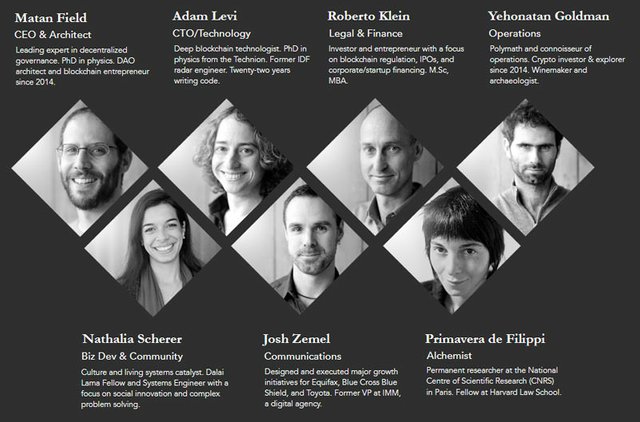
Advisors
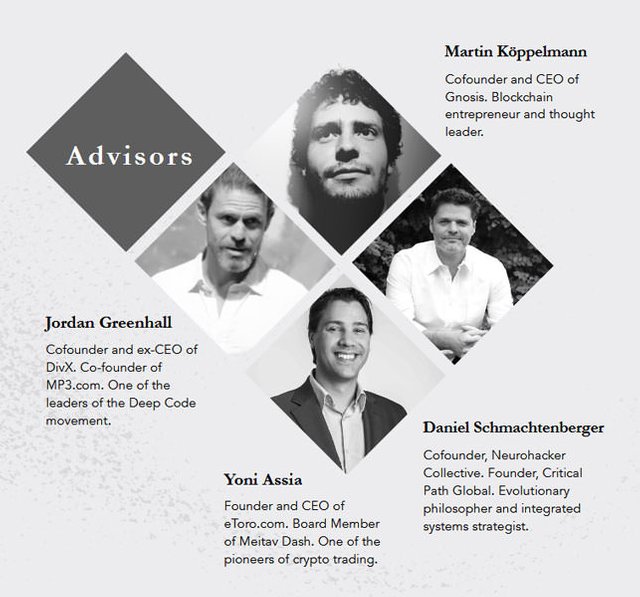
Partners
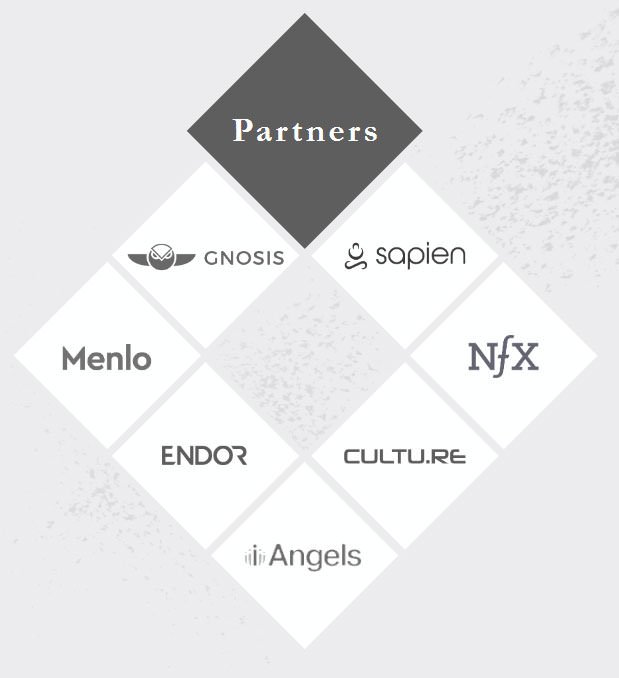
DAOstack Intro Video
More Information & Resources
- DAOstack Website
- DAOstack Summary
- DAOstack WhitePaper
- DAOstack Telegram
- DAOstack Twitter
- DAOstack Reddit
- DAOstack Newsletter
- DAOstack Github
- DAOstack Medium
- DAOstack YouTube
- DAOstack Token Sale FAQ

If you want to participate in this contest go to:
https://steemit.com/crypto/@originalworks/370-steem-60-bonuses-sponsored-writing-contest-daostack
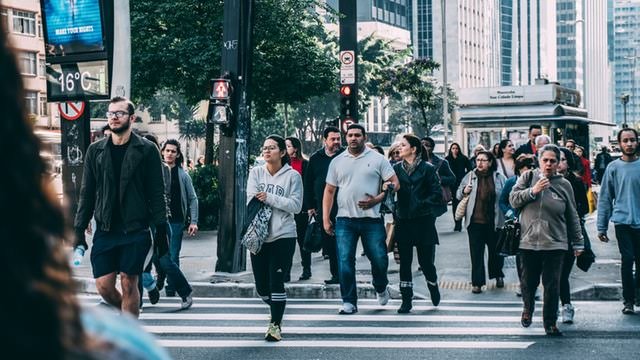
Submitted.
This publication has registered to the writing contest thanks to @jadams2k18.
writing contest thanks to @jadams2k18.
For more information, click here!!!!
See the Minnowhelper contest conditions here
You got a 1.83% upvote from @oceanwhale With 35+ Bonus Upvotes courtesy of @jadams2k18! Delegate us Steem Power & get 100%daily rewards Payout! 20 SP, 50, 75, 100, 150, 200, 300, 500,1000 or Fill in any amount of SP Earn 1.25 SBD Per 1000 SP | Discord server
You received a 8.01% upvote from @brotherhood thanks to @jadams2k18!,
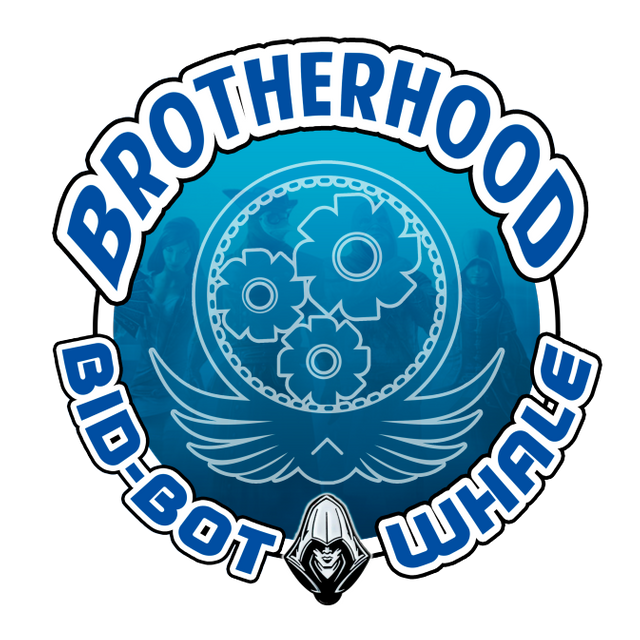
join on @brotherhood community on discord channel:https://discord.gg/3HZdaGk and share your post there.
Delegate to Bot and Get High Return Fix 100% earning return,
bidders will always win something and it will adapt to distribute all the 100% upvote ,now we reached to 23000 SP and recommend. send the 0.1 to 0.6 sbd or steem.
Congratulations! This post has been upvoted from the communal account, @minnowsupport, by jadams2k18 from the Minnow Support Project. It's a witness project run by aggroed, ausbitbank, teamsteem, theprophet0, someguy123, neoxian, followbtcnews, and netuoso. The goal is to help Steemit grow by supporting Minnows. Please find us at the Peace, Abundance, and Liberty Network (PALnet) Discord Channel. It's a completely public and open space to all members of the Steemit community who voluntarily choose to be there.
If you would like to delegate to the Minnow Support Project you can do so by clicking on the following links: 50SP, 100SP, 250SP, 500SP, 1000SP, 5000SP.
Be sure to leave at least 50SP undelegated on your account.
Great post! You've earned a 8.45% upvote from @dolphinbot

Join the DolphinBot Team for Daily Payouts in Steem! Click here: http://bit.ly/dolphinbot